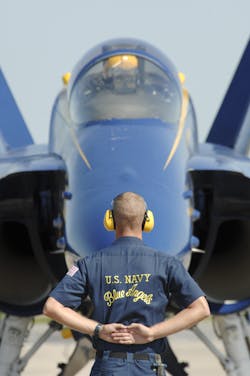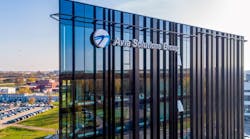This is a story about how the 1986 movie “Top Gun” transformed a young Irishman from being an aviation mechanic to becoming a highly educated Naval officer charged with overseeing maintenance for the world-famous Blue Angels Flight Demonstration Squadron.
Growing up in Ireland, Declan Hartney admits that he watched “Top Gun” one too many times. “I was always interested in U.S. military aviation. I was fascinated with the Navy, the aircraft it flew and the aircraft carriers. That really did it for me,” he says.
Hartney began his aviation career working as a mechanic for De Beers at Shannon Airport in 1990. “Although I was interested in aviation, there wasn’t a lot of opportunity for me in Ireland, since we had only one airline,” he recalls. “But then Shannon Aerospace built a new facility, which allowed young people like me to enter the industry.
“Shannon Aerospace was looking for maintenance technicians, so I applied for its aviation structural technician program. They say I was very enthusiastic during my interview, and I was accepted into its two-year program in May 1992,” says Hartney.
During the program, Hartney was trained in structural and composite repair on Boeing and Airbus aircraft. “It was a mix of classroom and hands-on training to do repairs on those aircraft,” he says.
Joined the Navy
After graduating in 1994, Hartney won the visa lottery to go to the United States. He immigrated, and two months later, joined the Navy as an aircraft maintenance technician.
Hartney’s first job in the Navy was as an aviation maintenance technician for the Strike Fighter Squadron 131 in July 1995. “The squadron, known as the Wildcats, was based at Naval Air Station Cecil Field in Jacksonville, FL. It flew F18s, the same fighter flown by the Blue Angels,” he says. “As I was doing my Naval training, we competed. Whoever finished top of the class got to pick the orders that were available. I was number two in a class of 35, so I got a wide choice of orders to choose from.”
His original choice -- the F14 Tomcat -- wasn’t available at the time. “So I took the next best thing, which was still a fighter jet,” says Hartney.
That was an intimidating time for Hartney. “Not only did I find myself in a foreign military, but I was also trying to fit into a new country. I had only been in the states a year when I started that first job,” he says. “I was still trying to figure things out. It was a fast work environment that encouraged a work hard, play hard mentality.”
In Ireland Hartney said he was a hard worker, but felt that he was being held back. “After I joined the Navy, the harder I worked, the more I was appreciated and rewarded. I felt like I fit in,” he said.
Blue Angels and Climbing the Ladder of Success
In October 1999 Hartney took his next job, as an aviation maintenance technician for the Blue Angels, when he started taking public speaking classes. “One good thing about being in the military is that it gives you the opportunity to go to college for free. I wanted to be an officer so I had to go to college, and I had to take public speaking courses as part of that,” he said. “It served me well with the Blue Angels when we traveled and visited schools and the public.”
From there, Hartney became the material control manager/airframes and powerplants division officer for Strike Fighter Squadron 146 during Operation Enduring Freedom in Afghanistan in 2002.
“As a material control officer, I had to balance the squadron’s budget and watch over spending. One of the biggest challenges was paying for fuel. If we got it off our ships, it was fine,” said Hartney. “But if we got it from Air Force or European tankers, it was a challenge. But the bottom line was we provided the squadron with mission-capable aircraft in Afghanistan.”
Hartney said he was also responsible for providing leadership for between 40 and 50 sailors who served as aircraft technicians. “The sailors specialized in structure and composite repairs, similar to what I did at Shannon Aerospace,” he stated. “I wasn’t just pushing paper. I could talk intelligently about the work they were doing. I understood what they did and could offer them advice and guidance.”
Later in his career, Hartney was tapped to create a special aviation maintenance department for the Navy’s Special Warfare Special Reconnaissance Team One in June 2010. “The team was operating a new aircraft platform that required a maintenance program in San Diego. My name came up as someone who could head this up,” he said. “As it turned out, it was the best tour I ever had. When I walked in, I was the maintenance department.”
Hartney built the department up, along with a program to support it logistically. “There was a lot of work that went into it and I enjoyed it. It was my baby for three years,” he said.
Take Advantage of Educational Opportunities
During that time, Hartney also took full advantage of the military’s free education program, getting his bachelor’s degree at Southern Illinois University, a dual master's degree in aviation safety and management from Embry-Riddle Aeronautical University, a master of arts in national security and strategic studies from the Naval War College and a Ph.D. from Northcentral University.
“After I got my bachelor’s degree, I decided I wanted to get my Ph.D. Again, I had big dreams. In order to get that, I had to get my masters and I did at Embry-Riddle. It was my intention to do my Ph.D. there too, but I got sidetracked to go to Naval War College,” said Hartney. “Going to war college was not an opportunity that maintenance officers usually got. It was a two-year detour and I enjoyed it and learned a lot. But once that was completed, I went back to my goal to earn my doctorate.”
The bachelor’s degree was what was needed to further Hartney’s career in the military. “Usually the military doesn’t look beyond that. For my career path it wasn’t advantageous, but it showed that I was ambitious and that I was a hard worker,” he said. “It would also give my commanding officers a good feel about me because I was going above and beyond what I was required to do.”
A career decision cut short Hartney’s original tour with the Blue Angels. “I didn’t regret the decision, but I always wanted to go back,” he said. “It took me three times to apply and get the job again, which was not an easy thing to do. I started again in September 2013.” His retirement from the Navy was official at the end of February.
Retirement, Not Quite
Now that he’s retired, Hartney said he wouldn’t mind staying in aviation in some capacity. Among the things he’s considering are program management with aerospace companies, unmanned aviation, airport management and aviation management for an airline. “It’s funny. As I’m going through this application process, companies like Amazon, Microsoft and Starbucks are also interested because of my military experience and leadership qualities,” he said.
Hartney said he can bring a lot of his military skills to the civilian world. “The most important of those skills is my attention to detail,” he said. “I can also be prepared, giving any boss the comfort of knowing they will get the best product from me.”
He’s had a few interviews, but is still waiting to hear back from companies. “I want to stay in the San Diego area, since I relocated here after retiring,” said Hartney.
Much can be learned from Hartney’s amazing career. “Never give up and if you know what you want to do, go get it. No one will give it to you, so don’t ever give up,” he advised. “I don’t have any regrets, and you need to live with the decisions you make.”
His advice for young people starting their aviation careers? Continue to learn and research the industry, said Hartney.
“This is something I did in my career. I wanted to expand my knowledge of aviation industry beyond what I was learning at the time, whether that was at Shannon Aerospace or in the Navy. It has served me well,” he said. “Get on industry websites and keep up with the news. Continuing to learn about your industry and getting to know it is key.”
Hartney said he’s always had big dreams. “When I talked to students and my teachers about moving to America and joining the Navy when I was in high school, they laughed at me,” he recalled. “They’re not laughing now. I pursued and carried out my dreams.”
Benét J. Wilson is founder and sole proprietor of Aviation Queen LLC, an aviation/travel freelance writing and consulting business. Currently, she is senior editor of sister publication Airport Business.


